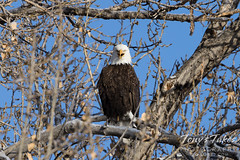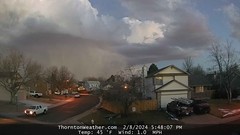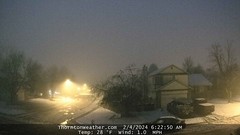
Denver’s weather is often a story of extremes and even in what is historically a calm period like February, significant events can and do occur. From record-setting Arctic cold that sent temperatures to far below zero to powerful, damaging wind, this week in Denver weather history has been an eventful one.
From the National Weather Service:
31-12
In 1899…a protracted cold spell lasted almost two weeks. Low temperatures plunged below zero on all days but February 9th with a reading of 6 degrees. The coldest low temperature of 22 degrees below zero on February 6th was a record low for the date. Low temperatures of 20 degrees below zero occurred on both February 11th and 12th… But only the 11th remains as the record minimum for the date. High temperature of only 5 degrees below zero on February 11th was a record low maximum for the date. High temperatures climbed to only zero degrees on both February 2nd and 3rd…but were not records. Intermittent light snow or flurries fell during the period. The most snowfall…2.0 inches…occurred on February 2nd.
5-11
In 1978…the 5th marked the start of a record 7 consecutive days of dense fog at Stapleton International Airport. The heavy fog reduced the visibility to 1/4 mile or less for a period of time on each of these days. Light snow and/or freezing drizzle occurred on most days. Fog reducing visibility to less than 7 miles was recorded at Stapleton International Airport on 11 consecutive days through the 15th. During the period 5-14…the cold thick fog deposited heavy rime ice up to 5 inches thick on power lines and poles over a wide area of eastern Colorado…causing a major electrical power outage disaster.
9-11
In 1965…heavy snowfall totaled 6.2 inches at Stapleton International Airport where northeast winds gusted to 25 mph.
In 1993…the same storm that dumped heavy snow in the mountains combined with an arctic cold front to produce heavy snow across metro Denver. Upslope snows of 4 to 8 inches were common with some areas receiving nearly a foot. Ten inches of new snow were measured in Parker and 7 inches in southeast Denver. At Stapleton International Airport… Snowfall totaled 8.1 inches. Strong winds combined with the snowfall to produce near-blizzard conditions over the plains closing many roads east of Denver. North winds gusted to only 18 mph at Stapleton International Airport on the 9th.
10-11
In 1971…a wind gust to 80 mph was recorded in Boulder at the National Center for Atmospheric Research. A wind gust to 69 mph was measured at the National Bureau of Standards. In downtown Boulder wind gusts to 43 mph were clocked. No damage was reported. North to northwest winds gusted to 39 mph on the 10th and to 41 mph on the 11th at Stapleton International Airport.
In 1999…heavy snow developed over sections of metro Denver during the evening hours. Snowfall totals included: 6 inches at Eaglecrest…6.5 inches at Highlands Ranch…and 8.5 inches about 5 miles south of Sedalia. Only 1.0 inch of snow fell at the site of the former Stapleton International Airport. Strong winds and snow caused near blizzard conditions north of metro Denver.
10-12
In 1958…heavy snow fell across metro Denver. At Stapleton Airport…where northeast winds gusted to 22 mph…6.7 inches of snowfall were measured.
In 1995…cold arctic air brought heavy snow to the foothills and western Denver suburbs. Golden measured 15 inches of snow with 14 inches in south Boulder. Locations in the foothills recorded between 10 and 15 inches of snow. Only 6.1 inches of snow fell at Stapleton International Airport where north winds gusted to 30 mph on the 10th.
10-13
In 1905…an extremely cold arctic air mass moved over the city behind a cold front on the 10th and persisted through the morning of the 13th. North winds were sustained to 25 mph behind the front on the 10th dropping the temperature to a low of 2 degrees below zero…which was also the high reading on the 11th. Light snowfall totaled 3.0 inches overnight of the 10th into the 11th. The low temperature plunged to 19 degrees below zero on the 11th. Records were set on the 12th and 13th. The high temperature of only zero degrees on the 12th was a record low maximum for the date. The low readings of 21 degrees below zero on the 12th and 14 degrees below zero on the 13th were record minimum temperatures for those dates.
11
In 1875…northwest winds were brisk all day. The velocities increased to 30 to 50 mph during the early evening.
In 1957…Chinook winds gusting to 49 mph warmed the temperature to a high of 64 degrees at Stapleton Airport.
In 1971…a rare February thunderstorm produced 1/4 inch diameter hail in southwest Denver.
In 1981…the cold spell of the 10th came to a quick end with strong Chinook winds. Gusts to 84 mph were recorded at mines peak and to 80 mph at Wondervu. Gusts in the foothills ranged from 50 to 65 mph. Southwest winds gusted to only 23 mph at Stapleton International Airport.
In 1984…a near-blizzard across eastern Colorado closed I-70 east of Denver and stranded 1200 motorists at Limon. Only 0.9 inch of snow fell at Stapleton International Airport where north winds gusted to 43 mph.
In 1988…wind gusts to 77 mph were measured at Echo Lake. West winds gusted to only 32 mph at Stapleton International Airport.
11-12 in 1899…the temperature plunged to lows of 20 degrees below zero on both days.
In 1900…northwest winds sustained to 52 mph with gusts to 60 mph warmed the temperature to a high of 58 degrees on the 11th. An apparent cold front overnight produced 3.7 inches of snow and northeast winds gusting to 30 mph. The high temperature on the 12th was only 26 degrees.
In 1994…moist upslope winds and an upper level storm system produced heavy snow over western portions of metro Denver. Snowfall amounts totaled 10 inches in Golden and 8 inches at Strontia Springs Reservoir 15 miles southwest of Denver in the South Platte canyon. Snowfall at Stapleton International Airport totaled only 3.6 inches…but north winds gusting to 35 mph on the 11th produced occasional visibilities as low as 1/4 mile in heavy snowfall and blowing snow.
11-12
In 1899…the temperature plunged to lows of 20 degrees below zero on both days.
In 1900…northwest winds sustained to 52 mph with gusts to 60 mph warmed the temperature to a high of 58 degrees on the 11th. An apparent cold front overnight produced 3.7 inches of snow and northeast winds gusting to 30 mph. The high temperature on the 12th was only 26 degrees.
In 1994…moist upslope winds and an upper level storm system produced heavy snow over western portions of metro Denver. Snowfall amounts totaled 10 inches in Golden and 8 inches at Strontia Springs Reservoir 15 miles southwest of Denver in the South Platte canyon. Snowfall at Stapleton International Airport totaled only 3.6 inches…but north winds gusting to 35 mph on the 11th produced occasional visibilities as low as 1/4 mile in heavy snowfall and blowing snow.
11-13
In 1903…west to northwest Chinook winds gusting to 34 mph warmed the temperature to a high of 50 degrees on the 11th… Before temperatures rapidly plunged to a low of 14 degrees behind a cold front. Light snow fell through the 13th and totaled 4.2 inches in the city…while temperatures ranged from a high of 14 degrees on the 12th to a low of 5 degrees below zero on the 13th.
12
In 1874…5 inches of snow fell in downtown Denver. Melted snow resulted in 0.31 inch of precipitation.
In 1875…forest fires burned very brightly in the foothills to the west of Denver.
12-13
In 1915…heavy snowfall totaled 7.0 inches over downtown Denver. Northwest winds were sustained to 24 mph on the 13th.
In 1951…heavy snowfall totaled 8.1 inches at Stapleton Airport where northeast winds gusted to 28 mph on the 12th.
In 1968…snowfall totaled 5.6 inches at Stapleton International Airport where northeast winds gusted to 26 mph. Snow fell all day on the 12th and into the morning hours of the 13th.
In 1997…heavy snow fell in the foothills southwest of Denver. Conifer…Evergreen…Morrison…and north turkey creek received 6 to 8 inches of new snow overnight. Only 0.2 inch of snow fell at the site of the former Stapleton International Airport. North-northeast winds gusted to 23 mph at Denver International Airport on the 13th.
12-16
In 2021…the daily low temperatures dropped to zero degrees or colder through the 5-day stretch. These were the only sub-zero temperatures recorded for the 2020-21 winter season. Even the maximum daily temperatures during this stretch were cold…with highs only managing to warm into the single digits on the 13th and 14th.
13
In 1886…northwest winds were sustained to 40 mph during the early morning hours…but winds were strong and gusty all day.
In 1918…west winds were sustained to 42 mph with a measured extreme velocity to 44 mph. The strong Chinook winds warmed the temperature to a high of 58 degrees.
In 1988…high winds raked metro Denver. Boulder reported a wind gust to 67 mph with 63 mph at Lakewood and 49 mph at Stapleton International Airport. The strong winds toppled a tree onto a car in Aurora. Northwest winds gusting to 49 mph at Stapleton International Airport warmed the temperature to a high of 64 degrees.
In 2010…a peak wind gust to 89 mph was recorded in Boulder. North winds gusted to 28 mph at Denver International Airport.
Continue reading February 11 to February 17: This Week in Denver Weather History →
































































